- Details
- Hits: 3323
Crossing: Bimo Junction, MI
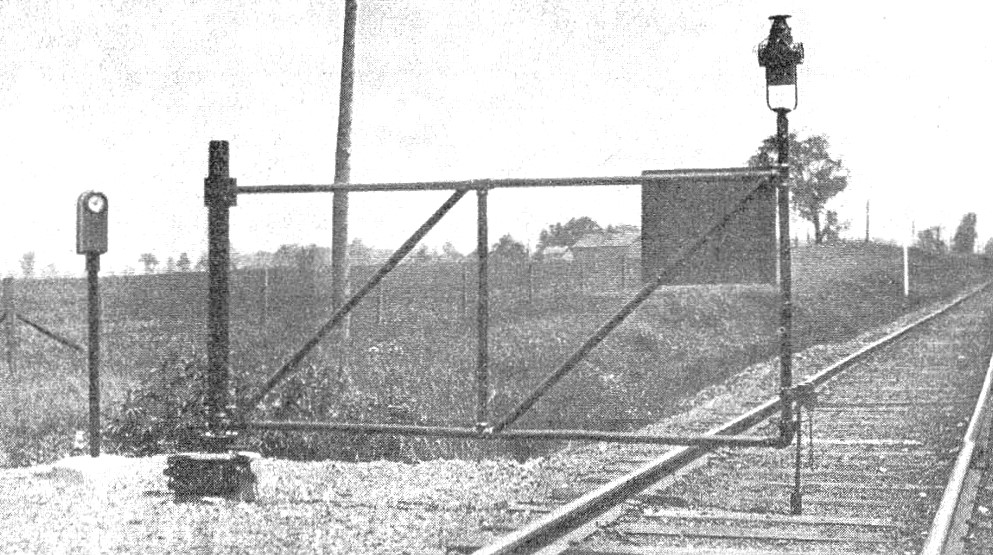
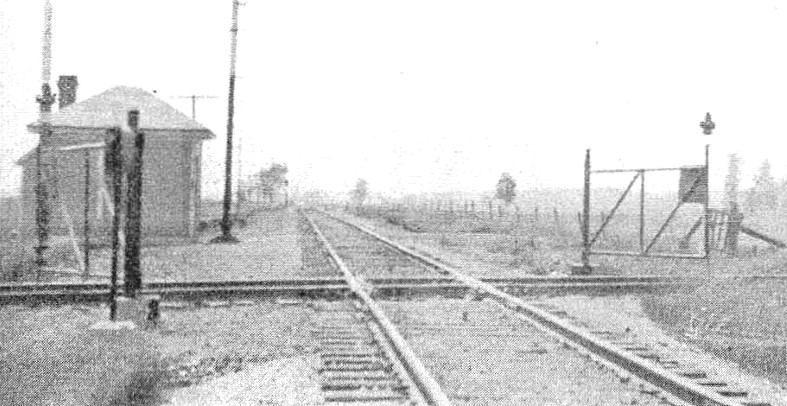
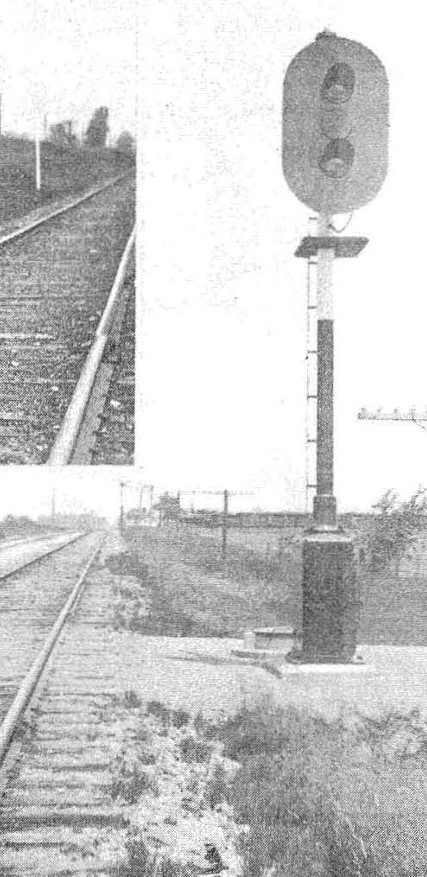
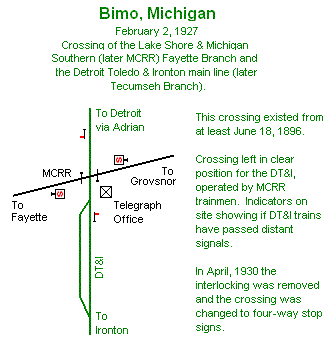
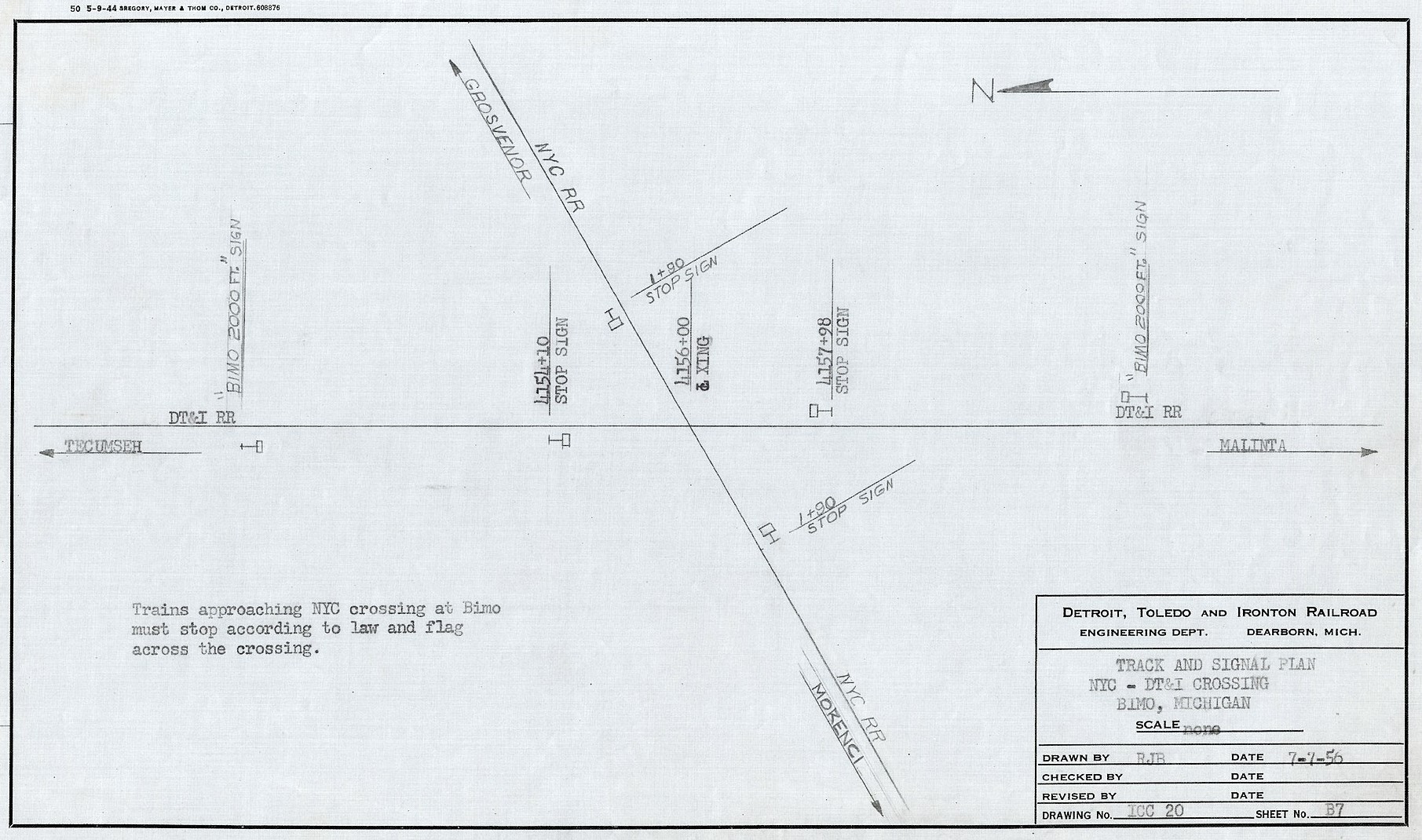 Bimo was settled about 1896 as a station on the Lake Shore & Michigan Southern. [MPN]
Bimo was settled about 1896 as a station on the Lake Shore & Michigan Southern. [MPN]
Bimo Junction was the grade crossing of the Detroit, Toledo & Ironton railroad Tecumseh branch (original main line) and the New York Central Fayette Branch. The crossing had very low volume and was protected by stop signs most of its life. The crossing was four miles northeast of Morenci, Michigan.
Image info: Top, the crossing gate at Bimo, which was operated by LS&MS trainmen. The pedestal box to the left gives the train crew an indication if there are DT&I trains approaching on the track circuit. 2nd image is a wider view of the same crossing with a small station nearby. This also shows that there were two gates, which is not always the case. 3rd image is a DT&I signal on their route at the crossing. Note that middle aspect is missing, with this signal giving only a red or green aspect. This may be an approach signal. [RSE-1920-3] 4th image, a drawing of the crossing take from the state of Michigan archives. [Dale Berry]. 5th image, a 1956 DT&I track diagram at Bimo. The DT&I track had approach signs, as well as stop signs on both routes.
Notes
According to the book Michigan Place Names, Bimo was a station on the Lake Shore & Michigan Southern and had its own post office from 1896 to 1903. The Fayette branch was never more than a 1 train each way per day sleepy branch line. Over the years, it was cut back to Morenci, and then abandoned altogether in the 1980's. The DT&I line was originally the main line for the Detroit & Lima Northern, which then became the DT&I. But after Ford interests bought the DT&I, they straightened the DT&I's main line, converting this route into a branch line which went north through Adrian to Tecumseh. This was not a busy location at any time, and in fact sat in the midst of farm land.
Location: 41o44.989'N / 84o09.027'W.
The photos above suggest that this was a second class interlocking with signals on the DT&I and gates on the Fayette Branch of the LS&MS.
Time Line
April 16, 1930: The Michigan Public Utilities Commission authorizes changes in the interlocking here due to minimal traffic on the DT&I since the Malinta cut-off has been put into operation. [MPUC-1930]
Article About Bimo in Railway Signal Engineer - 1927
Half Interlocker on D.T.&I
At the intersection of the main line of the Detroit, Toledo & Ironton with the Fayette Branch of the New York Central at Bimo, Mich., the first half-interlocker has been completed on the former road. The heavy volume of traffic on the DT&I, combined with stiff grade made it necessary to provide protection at this rail intersection, because under the regulations many unnecessary train stops and delays to trains occurred. Prior to the new installation it was necessary to stop all trains and flag them over the crossing in accordance with the state regulations.
Two-position color-light home signals located 700 ft. in advance of the crossing, displaying red for "stop" and green for "proceed" and semaphore type distant signals 2,000 ft. in advance of the home signals, displaying a fixed caution indication comprise the signaling facilities. The home signals are approach-lighted, being operated from 10 cells of Edison 500 a.h. primary battery and controlled by the manual operation of the crossing gates at the intersection. The track circuits are fed by 3 Edison cells in multiple. Normally the gates are lined up across the NYC tracks thus allowing DT&I trains to operate under proceed signals over the crossing without stopping,
To provide information as to the approaching trains on the DT&I for the benefit of NYC trainmen a semaphore indicator has been installed and serves the same function as at a main line switch. That is, the NYC trains stop at the crossing under normal operating conditions and the train men note from the semaphore indicator whether or not a DT&I train is approaching. If not, the gates are reserved, thus causing the DT&I home signals to display a stop indication. Upon completion of the movement of the NYC train over the crossing, the gates must be restored to their normal position over the NYC tracks after the train has been flagged over the crossing, thus changing the DT&I home signals to the green or proceed indication normally displayed.
As a fully automatic signaling interlocking plants the Bimo installation is without derails. Passenger trains on the DT&I are permitted to operate over the crossing at a speed of 30 miles an hour while freight trains are permitted to cross at a maximum speed of 20 miles per hour. [RSE-1927-12]
Bibliography
The following sources are utilized in this website. [SOURCE-YEAR-MMDD-PG]:
- [AAB| = All Aboard!, by Willis Dunbar, Eerdmans Publishing, Grand Rapids ©1969.
- [AAN] = Alpena Argus newspaper.
- [AARQJ] = American Association of Railroads Quiz Jr. pamphlet. © 1956
- [AATHA] = Ann Arbor Railroad Technical and Historical Association newsletter "The Double A"
- [AB] = Information provided at Michigan History Conference from Andrew Bailey, Port Huron, MI

